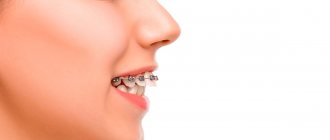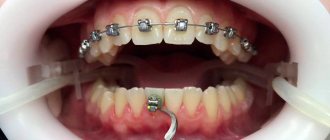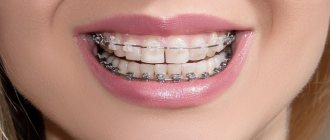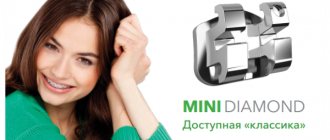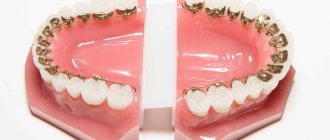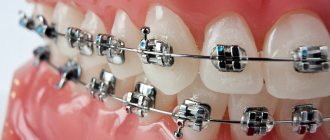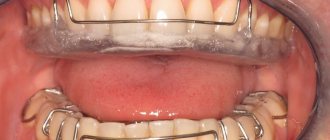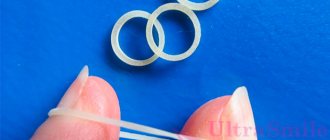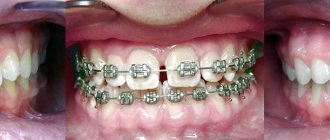01.12.2019
A charming snow-white smile is impossible without healthy and straight teeth. Modern orthodontic dentistry offers many options for teeth whitening and straightening; one of these methods is the installation of special devices - braces. Is it possible to put braces on one jaw if the other row of teeth does not need to be straightened? Let's consider the issue in detail.
CORRECT BRACKET INSTALLATION
Many patients resolutely refuse to install braces on both rows, explaining their refusal by the inappropriateness of straightening non-crooked teeth in the lower/upper row. However, not all so simple. The function of braces is not only to correct curvature, but also to straighten the bite.
The bite is responsible for the closure of the teeth of the lower and upper rows. The quality of grinding food in the oral cavity, and therefore the proper functioning of the entire digestive system, depends on the correct bite. However, patients in orthodontic clinics do not know about this. Moreover, malocclusion does not bother them.
What happens when orthodontic appliances are placed on only one jaw? Before the patient came to the clinic, the human jaw had been shaped for many years to a certain position of the rows, that is, the lower row with straight teeth was adjusted to the upper row with crooked ones. After straightening the upper row, the patient begins to notice that closure has become problematic.
Is it possible to install structures only on the upper jaw without negative consequences for the bite? Yes, it's possible. However, before making such a decision it is necessary:
- take an x-ray of the jaw;
- check the condition of bone tissue;
- check the condition of the root system of the teeth.
Only after a thorough examination of the jaw can a specific decision be made. If the orthodontist recommends braces on the upper jaw, this does not mean that the lower jaw will not be under control. The doctor must monitor the condition of the lower jaw during the process of adjusting the upper jaw, and take preventive measures in time. For example, retainers—removable orthodontic structures—can be used to correct the lower jaw. Retainers are worn at night or worn for an hour during the day.
Contraindications for installing braces
Installation of the system is not an invasive procedure, however, the braces still come into one degree or another in contact not only with the teeth, but also with the gums, adjacent tissues of the cheeks, and tongue. Before you find out how much it costs to install lower braces, check out a number of contraindications:
- Diabetes;
- Blood diseases;
- Foci of inflammation in the oral cavity;
- HIV;
- Tuberculosis;
- Immune system diseases;
- Osteoporosis;
- Psychical deviations;
- Other diseases.
Diseases such as periodontal disease, gingivitis, caries - they must first be cured, and only then braces should be installed. Installation is also not recommended if there is increased bleeding of the gums and poor wound healing. When part of the system is damaged, it is difficult to stop the bleeding, and the resulting wounds take a long time and heal poorly.
With osteoporosis, bone tissue is weakened, the pressure of braces on the teeth can play a cruel joke and lead to tooth loss. For diseases of the immune system, any additional stress on the body can have a negative effect, so installing braces is not recommended.
TYPES AND DESIGN OF BRACKETS
Is there a difference between upper and lower jaw braces? In practice, the installation of braces on the top row has become more widespread. This is explained by the desire of patients to achieve a beautiful smile. The lower teeth are not always visible when talking and smiling, so few people care about the evenness of the lower row.
For the upper row, there are many types of orthodontic structures made of different materials. There are expensive aesthetic braces, and there are cheaper ones. If the design features of the braces are chosen by the orthodontist according to the patient’s jaw type, then the choice of material for making the braces depends on the financial and aesthetic needs of the person.
Depending on the design features, braces are:
- ligatures;
- self-regulating;
- lingual;
- removable mouthguards.
Ligature structures cause discomfort to the patient due to changes in the chewing load. It is not possible to correct the situation; the patient is forced to get used to the pressure. Self-adjusting braces can be adjusted independently depending on how you feel. However, they also cost more than ligature ones.
The most expensive are lingual braces, which are attached to the inside of the jaw. These structures are completely invisible and do not cause aesthetic discomfort to the patient. The advantage of the lingual system is ideal closure - they do not affect the bite. The high cost of these devices is explained by the use of expensive metal alloys in the composition (sometimes with gold plating). The disadvantage is a temporary impairment of diction when wearing the device.
Removable aligners are used to correct one or two crooked teeth. The advantage of mouthguards is their low price. Disadvantage - they do not provide ideal evenness to the entire dentition due to pinpoint impact, and do not affect the correction of the bite.
How much does it cost to install lingual braces in Moscow?
The main advantage of lingual braces is their aesthetics, because they are not visible to prying eyes. They are installed on the inside of the teeth, which is much more difficult than the classic installation on the outside, and therefore the cost of the work will be higher.
The second advantage of the system is the obviousness of the result. Before installation, a 3D model is created, on which you can immediately see the final result of the bite correction.
However, such braces have their disadvantages. The main one is pain. Diction is impaired during the first time after installation, and the tongue can be damaged by part of the system during habituation. And the treatment takes longer than with conventional braces.
How much does it cost to install a lingual brace system? The treatment will be quite expensive, since the doctor’s work becomes more complicated, and this is included in the cost of the design. However, the aesthetic factor easily justifies the high price in some cases.
MATERIAL FOR MANUFACTURING ORTHODONTIC SYSTEMS
The choice of material for orthodontic structures is quite wide:
- metal;
- plastic;
- ceramics;
- dental sapphire.
Metal ones are the cheapest. Metal braces look scary, but they are one of the best in terms of treatment effectiveness. The metal does not stain when worn, does not bend or break.
Patients try to choose inconspicuous structures made of plastic/ceramics/sapphire for the upper jaw. However, everything has its own characteristics. For example, plastic braces begin to turn yellow over time and may not withstand the load - they break. Such designs can be worn for no more than six months with a slight curvature of the row.
Ceramics are more resistant to stress compared to plastic. Ceramic braces can be almost invisible if the color of the material is matched to the tone of the enamel. Sapphire braces are made from a special crystal grown under certain conditions. Such hardware structures are not inferior in strength to metal ones and are not noticeable. The whole issue is the high price.
Braces care
Why should you take extra care of your braces? First of all, it should be taken into account that the system is installed for a long period, sometimes up to 2-3 years, and provokes increased formation of plaque and tartar. And a large number of hard-to-reach places create a favorable environment for the proliferation of pathogenic bacteria.
Rules for caring for any brace system can be summarized as follows:
- Clean your mouth after every meal.
- Clean not only the teeth themselves, but also all accessible elements of the system that you can reach with a brush.
- Brush your teeth for at least 4 minutes.
- Use brushes, paste, and other equipment and devices that are designed specifically for braces.
- Change the toothpaste occasionally; it is recommended to use toothpastes with a high content of calcium and fluoride to strengthen the enamel.
- Do not miss the interdental space, clean it with floss or irrigator.
- After brushing your teeth, rinse your mouth with a special mouthwash that will help remove food particles from hard-to-reach places where a toothbrush cannot reach.
- Treat parts of the system with a special brush or brush.
Quite a lot of specialized brushes, pastes and other equipment will come in handy when wearing the system, so when you calculate how much it costs to get braces, don't forget to add the cost of the required care kit.
WHAT TO PUT ON THE UPPER JAW?
Correcting the upper dentition is an exciting procedure for patients. This is the most popular correction due to aesthetic discomfort when smiling. Few people worry about the correct bite: the only question is psychological comfort. Is it possible to partially install an ortho structure on the top row? This is possible in the following cases:
- if the patient has a well-formed bite;
- if one or two teeth need to be corrected.
The choice of bracket material depends on cost. Many patients choose lingual appliances that are hidden from view when talking and smiling.
Removing teeth before installing braces
In some cases, one or more teeth will have to be removed before braces can be placed. So, with a small jaw, the teeth are too crowded, they do not fit into one row of teeth. Excess elements are removed, after which a braces system is installed to correct the dentition.
There are a number of indications when teeth must be removed:
- Extensive caries damage;
- Presence of a cyst;
- The tooth is very loose;
- The root of the tooth is significantly damaged;
- Osteomyelitis;
- Other.
Wisdom teeth are removed only if they are the cause of malocclusion, are in the wrong position, or have an inflammatory process. In other cases, it is not necessary to remove the wisdom tooth. The doctor makes the decision to remove other teeth based on individual characteristics, and is guided by the fact that facial features are not deformed and functionality is not impaired.
WHAT TO PUT ON THE LOWER JAW?
In what cases is it necessary to install an orthodontic system only on the bottom row? The decision to correct the lower row is made by the doctor based on an examination of the patient’s jaw. If the teeth of the upper row and the bite do not need correction, braces are placed on the lower jaw.
However, in practice there are cases where it is necessary to re-install brackets on the upper jaw after correcting the lower jaw. Why is this happening? Because while wearing appliances on the lower jaw, the bite changed. If a doctor unexpectedly offers correction of the upper teeth after correcting the lower ones, he is not trying to make money on the patient - he is offering to correct the changed bite.
It is advisable to choose the material of orthodontic structures for the top row that is less noticeable - this is due to the aesthetic side of the issue. What about devices for the lower jaw, and is it possible to put braces on the lower jaw without the upper jaw?
The lower row of teeth is not always visible when talking and smiling, so orthodontic structures in this part of the jaw do not bring aesthetic discomfort to patients. When choosing braces for the lower teeth, it is necessary to take into account, first of all, the absence of pain when worn. Therefore, you can choose self-regulating metal structures (cheaper), but the best option is to install a lingual system.
Why is it recommended to install a lingual orosystem on the bottom row? This choice is dictated not by aesthetic considerations, but by the practical urgency of the issue. When installing braces only on the bottom row, difficulties may arise with closure: the position of the bite changes. To prevent the bite from changing, it is recommended to install ortho systems on the inner surface of the teeth.
How much does it cost to install self-ligating (ligature-free) braces on teeth?
The main difference from ligature systems is the absence of additional parts for fastening. Which in turn allows the teeth to move without overcoming the frictional force (which is created by ligatures in other systems), which is much more comfortable.
There are many advantages to such a system:
- They look neater, since the clasps look smaller, although in fact they are about 1 mm larger than the ligature system.
- The manufacturing material does not react with saliva.
- Getting used to it is easier and faster.
- Due to less friction, treatment is faster and lasts about a year on average.
- There is no need to remove “extra” teeth.
- Correction is carried out once every 3 months.
- Quick installation and removal of the system.
- Possibility of use in the presence of periodontal diseases.
The only downside to such a system is the price. How much does it cost to install self-ligating braces for a year? The cost will be 1.5-2 times higher than the ligature system.
BRACKETS OR SPELLS - WHAT IS BETTER?
What to do if only one tooth is crooked? This occurs in the practice of orthodontists. If your bite is normal, your doctor may suggest removable clear aligners. Such structures are placed on a molar or incisor that does not have enough space on the jaw. Typically, aligners are worn for only a few months. However, mouthguards are not used in all cases: if the tooth has turned to the side, treatment with braces is prescribed. Typically, canines and front incisors are corrected with mouthguards.
Placing transparent aligners is much cheaper. But is the question of price always justified? Let's look at the advantages of braces over removable aligners:
- The bracket system puts constant pressure on the tooth, which speeds up the process of straightening the curvature.
- With the help of removable structures (alignments), it is problematic to achieve ideal evenness of the dentition.
- Braces are more convenient to use than mouthguards.
- Braces do not affect pronunciation: the patient does not have a lisp.
How long does it take to correct the bite and teeth using braces? This usually takes a period of ten months. For children, the period of wearing orthodontic structures doubles - this is due to the eruption of all permanent molars.
How much does it cost to install ligature braces?
A distinctive feature of this brace system is the multi-colored “rubber bands” (ligatures), with the help of which the braces are fixed to the orthodontic arch. The color can be absolutely any.
There are several main advantages: aesthetic diversity, and you can change the color of the ligatures directly during treatment. And low price. How much does it cost on average to install these braces? The cost will be one of the most reasonable on the market; you will be informed of the exact price only after consultation and determination of the degree of bite deformation.
When choosing this design, remember that you will have to visit the doctor more often (the elastic elements stretch), and the treatment will take longer. Coloring with food coloring is also possible.
LET'S SUM UP
Are braces placed on one jaw? Partial installation of orthodontic systems is possible in the following cases:
- absence of serious problems with the patient’s bite: each tooth in the upper jaw is opposite the corresponding tooth in the lower jaw;
- absence of multiple curvatures of the row.
If the patient's bite is normal, the orthodontist will suggest partial installation of braces. If the patient needs bite correction, the entire jaw should not be corrected.
There are cases of single curvature of teeth in the upper or lower row - one or two. Then the orthodontist offers partial installation of a brace system as needed (if the patient’s bite is correctly formed).
Is it possible to put braces only on the upper jaw? Theoretically, yes. In practice, the issue comes down to the formation of a correct bite, which is of particular importance for the human gastrointestinal tract. Since both jaws take part in the formation of a correct bite, orthodontic structures should be installed on both rows of teeth.
The use of removable aligners to correct one or two uneven teeth is not always justified. Firstly, it is impossible to achieve perfect row evenness. Secondly, there is constant discomfort when wearing it, and it takes a long time to get used to it. Thirdly, mouthguards do not straighten the bite.
Which braces are the best? Only an orthodontist can determine this. For aesthetics, lingual constructions are better suited, although they are the most expensive. Also, lingual appliances provide ideal closure: they do not disturb the bite. However, such appliance designs are not suitable for short teeth.
Prices
| View | Set for one jaw | Installation | Installment plan |
| Metal | from 30,000 rub. | from 20,000 rub. | 7,000 - 9,000 rub./month |
| Sapphire | from 50,000 rub. | from 30,000 rub. | 10,000 rub./month |
| Ceramic | from 45,000 rub. | from 30,000 rub. | 10,000 rub./month |
| Plastic | from 40,000 rub. | from 30,000 rub. | 10,000 rub./month |
| Other types | from 40,000 rub. | from 30,000 rub. | 10,000 rub./month |
Diet rules when wearing braces
In the first few days, chewing food may be painful as pressure is placed on the teeth and the ligaments are stretched. These days it is recommended to eat yoghurt, porridge, puree soup, vegetable or fruit smoothies.
After the teeth have adapted, you can eat anything, but there are a number of restrictions:
- Solid foods. Nuts, crackers, carrots, seeds, dried fruit, tough meat, etc. - all this requires additional effort when biting, which can lead to the bracket coming off and parts breaking. This means you will have to replace the faulty part, and now how much does it cost to install upper braces? Plus the cost of broken parts.
- Small grains and cereals. Such loose products can get stuck in parts of the product, break it, or begin to have a negative effect and lead to caries, for which the system will have to be removed.
- Sticky products. Like the previous point, stretchy products damage the product itself and lead to caries.
- With dyes. The main danger is a change in the color of the braces and loss of aesthetics.
If you follow all the recommendations, there will be no problems with the braces system, and an even and beautiful smile will delight you throughout your life!
